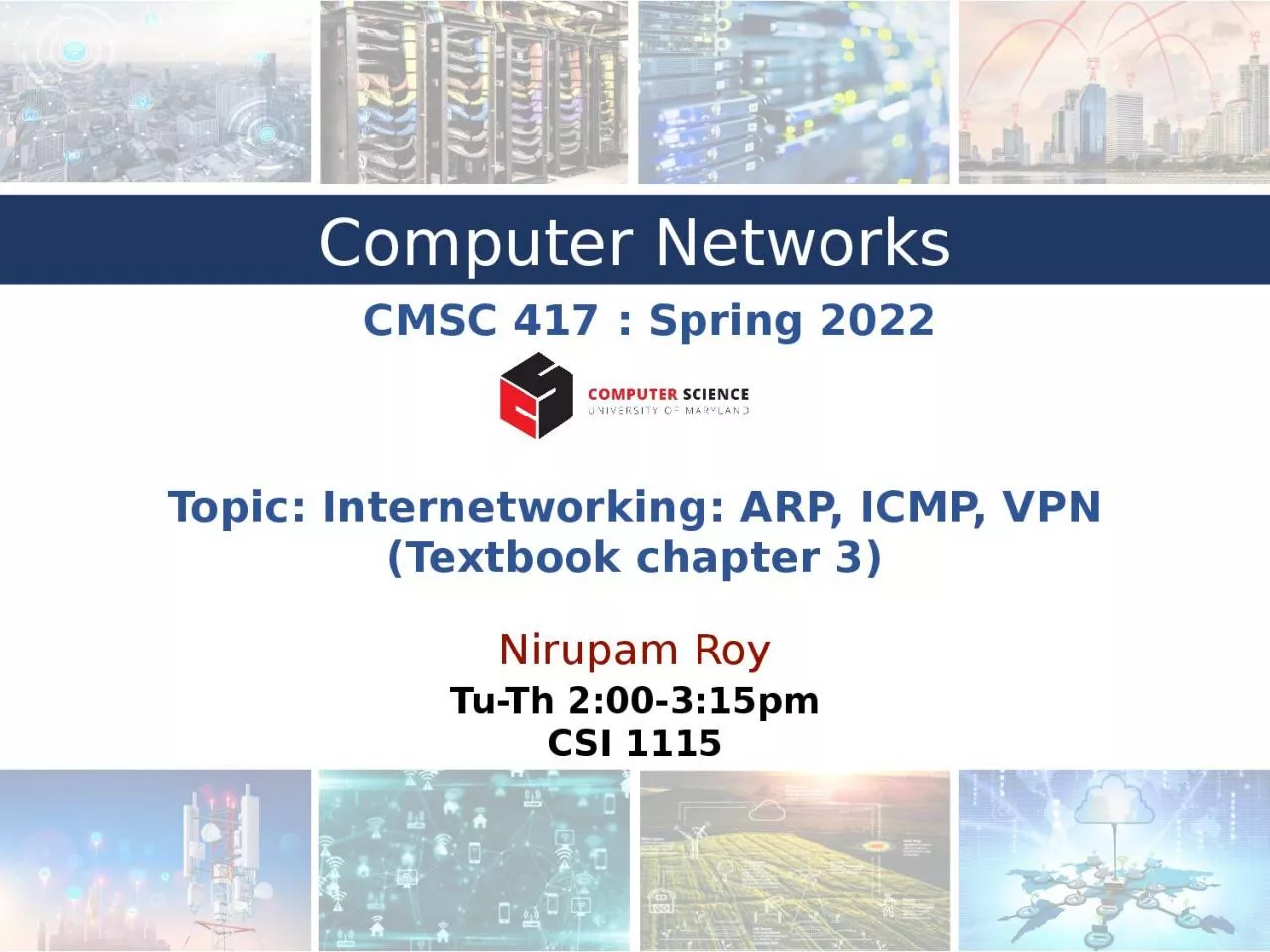

TuTh 200315pm CSI 1115 CMSC 417 Spring 2022 Topic Internetworking ARP ICMP VPN Textbook chapter 3 Network address vs LAN address 2 Destination Source Router Two perspectives of addresses ID: 919369
Download Presentation The PPT/PDF document "Computer Networks Nirupam Roy" is the property of its rightful owner. Permission is granted to download and print the materials on this web site for personal, non-commercial use only, and to display it on your personal computer provided you do not modify the materials and that you retain all copyright notices contained in the materials. By downloading content from our website, you accept the terms of this agreement.
Slide1
Computer Networks
Nirupam Roy
Tu-Th 2:00-3:15pm
CSI 1115
CMSC 417 :
Spring 2022
Topic: Internetworking: ARP, ICMP, VPN
(Textbook chapter 3)
Slide2Network address
vsLAN address
2
Slide3Destination
Source
Router
Two perspectives of addresses:
(1)Network-to-network & (2)machine-to-machine
Slide4Source
Router
application
transport
network
link
physical
Slide5Source
Router
network
link
physical
application
transport
network
link
physical
Slide6Router
Hierarchical address for addressing networks
(IP address)
network
link
physical
Slide7Source
Router
application
transport
network
link
physical
network
link
physical
Slide8Source
Router
application
transport
network
link
physical
network
link
physical
Flat address for addressing machines at the link-layer
(MAC address)
Slide9Address Resolution Protocol (ARP)
9
Slide10MAC addresses and
ARP32-bit IP address: network-layer address for interfaceused for layer 3 (network layer) forwardingMAC (or LAN or physical or Ethernet) address: function: used “locally” to get frame from one interface to another physically-connected interface (same network, in IP-addressing sense)
48 bit MAC address (for most LANs) burned in NIC ROM, also sometimes software settablee.g.: 1A-2F-BB-76-09-AD
hexadecimal (base 16) notation
(each
“
numeral
”
represents 4 bits)
10
Slide11MAC addresses and ARP
each adapter on LAN has unique
LAN
addr
. or MAC
addr
.
adapter
1A-2F-BB-76-09-AD
58-23-D7-FA-20-B0
0C-C4-11-6F-E3-98
71-65-F7-2B-08-53
LAN
(wired or
wireless)
11
Slide12MAC addresses (more)
MAC address allocation administered by IEEE
manufacturer buys portion of MAC address space (to assure uniqueness)analogy:MAC address: like Social Security NumberIP address: like postal address MAC flat address ➜ portability can move LAN card from one LAN to anotherIP hierarchical address not portable address depends on IP subnet to which node is attached
12
Slide13ARP: address resolution protocol
ARP table:
each IP node (host, router) on LAN has tableIP/MAC address mappings for some LAN nodes: < IP address; MAC address; TTL>TTL (Time To Live): time after which address mapping will be forgotten (typically 20 min)
Question:
how to determine
interface’s MAC address, knowing its IP address?
1A-2F-BB-76-09-AD
58-23-D7-FA-20-B0
0C-C4-11-6F-E3-98
71-65-F7-2B-08-53
LAN
137.196.7.23
137.196.7.78
137.196.7.14
137.196.7.88
13
Slide14ARP Packet Format
HardwareType: type of physical network (e.g., Ethernet)
ProtocolType: type of higher layer protocol (e.g., IP)HLEN & PLEN: length of physical and protocol addressesOperation: request or responseSource/Target Physical/Protocol addresses
Slide15ARP protocol: same LAN
A wants to send datagram to BB’s MAC address not in A’s ARP table.A broadcasts ARP query packet, containing B's IP address destination MAC address = FF-FF-FF-FF-FF-FF (Link layer broadcast address)all nodes on LAN receive ARP query B receives ARP packet, replies to A with its (B's) MAC address
frame sent to A’s MAC address (unicast)A caches (saves) IP-to-MAC address pair in its ARP table until information becomes old (times out) soft state: information that times out (goes away) unless refreshedARP is “plug-and-play”:
nodes create their ARP tables without intervention from net administrator
15
Slide16Address Translation Protocol (ARP)
Map IP addresses into physical addressesdestination hostnext hop routerTechniquesencode physical address in host part of IP addresstable-basedARP (Address Resolution Protocol)
table of IP to physical address bindingsbroadcast request if IP address not in tabletarget machine responds with its physical addresstable entries are discarded if not refreshedQuery message include the physical address of the sending host. Why?
Slide17Internet Control Message Protocol (ICMP)
17
Slide18Internet Control Message Protocol (ICMP)
Defines a collection of error messages that are sent back to the source host whenever a router or host is unable to process an IP datagram successfullyDestination host unreachable due to link /node failureReassembly process failed
TTL had reached 0 (so datagrams don't cycle forever)IP header checksum failedICMP-Redirect From router to a source hostWith a better route information
Slide19ICMP message types
Slide2020
Ping example
Slide21Traceroute : An unintuitive application using ICMP
Slide2222
Traceroute example
Slide23Traceroute : An unintuitive application
Slide24Virtual Networks and Tunnels
24
Slide2525
Slide26Slide2727
Slide2828
Why do we need virtual networks or tunnels?
1. Security
2. Special capabilities between routers (e.g., multicast)
3. Supporting heterogeneity
Disadvantages:
1. Increases packet length
a) Wastage of bandwidth
b) More processing
c) Fragmentation
2. Increases management cost
Slide2929
A note on the “subnet mask”
Slide3030
inet
10.104.216.101
00001010.01101000.11011000.01100101
netmask ff:ff:f0:00
11111111.11111111.11110000.00000000broadcast 10.104.223.255 00001010.01101000.11011111.11111111